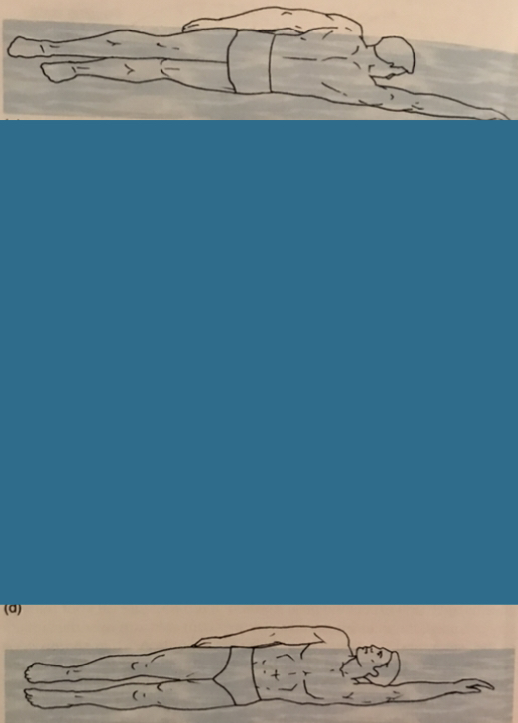Side Glide with Breathing (SGB) Swim Drill
Side glide with breathing is an alternation between SGNU and SGND swim drills. Start as you would fro SGNU drill. With good posture and balance, take several breaths in this nose up position, turn you head so that your nose points toward the bottom of the pool, and exhale a little bit of air underwater into your armpit. The turn your head back to the nose-up position. Take several breaths in this position before turning your head to exhale underwater. The only thing you move in this drill, besides your legs, is your head. The body should stay in a balanced, side-glide position throughout this drill. As you practice this drill, work toward exhaling more air each time you are nose down and try to take fewer breaths each time you turn your head to the nose-up position until you can exhale normally underwater and until you can take a single breath when nose up. Do this drill on both sides.

Feedback for Side Glide with Breathing
1. When your nose points up, your head should be in the same position as in the SGNU drill -- ears under the water. When your nose points toward the bottom, just the back of your head is exposed to the air. The idea is to rotate your head as if it were on a skewer (one that runs through your spine and up through your crown) without bending the skewer.
2. Feel for that dry strip of flesh all the way down your side arm, from your shoulder to your wrist, at all times during this drill. Many swimmers tend to lift the head a bit when turning to the nose-up position. This causes the hips to drop. You'll feel the water line creep up your side arm toward your shoulder, indicating that you have lost your balance. You may need to press your side and the back of your head slightly toward the bottom of the pool in order to avoid lifting it as you rotate it to the nose-up position.
3. Another common tendency with this drill is to lean on the extended arm, pressing it toward the bottom of the pool as the head turns for a breath. This is an attempt to artificially support a slightly lifted head. The cure is to support yourself by leaning on your buoy more and by keeping the extended arm as a slightly downward angle. This arm should feel weightless throughout the drill.
Experiment a Bit
As with all the posture and balance swim drills, it is helpful to spend time consciously shifting back and forth between holding a tight-line posture line and relaxing into a schlumpy posture. Becoming aware of how the two different postures affect your swimming will help motivate you to make a habit of good posture.
back to the top of side glide with breathing








